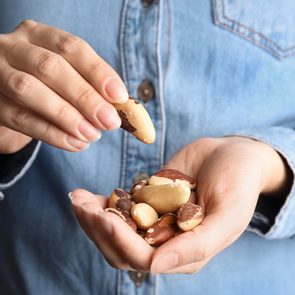Yes, You Can Lower Your Breast Cancer Risk—Here’s How

Breast cancer isn't always preventable, but you can manage the risks presented by these three contributing factors.
Among the remaining mysteries of breast cancer is a very basic one: its causes. It’s not unusual for women to develop this form of cancer without having a single one of the known risk factors.
Many of the breast cancer risk factors identified so far—particular genes, family history, late menopause, dense breast tissue and so on—are beyond your control. Nevertheless, there are a few preventive steps you can take.
How to Lower Your Risk For Breast Cancer
Drink lightly
Epidemiologic studies around the world have found that the more alcohol someone imbibes on a regular basis, the greater the increase in risk. “This link is quite well-established now, even though it’s not one of the cancer facts that’s getting much attention,” says Kevin O’Hagan, a spokesperson for the Irish Cancer Society.
Even two drinks a day increases the breast cancer rate compared to abstaining, though only by seven to 16 per cent. (By contrast, a BRCA1 gene mutation like the one Angelina Jolie carried can increase a woman’s risk by up to 2,900 per cent.) A possible explanation: alcohol raises estrogen levels, which promotes some types of breast cancer, while lowering levels of essential nutrients, like folate and vitamin A, that protect against cell damage.
Be wary of hormonal treatments
Extra estrogen and progesterone exposure are also the reasons why women should give careful consideration to hormonal treatments—including hormone replacement therapy and birth control pills. There is good news for pill users, however: a woman’s breast cancer risk returns to baseline levels by the time she’s been off the pill for about 10 years. For many women, one or both of these treatments might be worth the modest increase in breast cancer risk, given the benefits of contraception and menopausal symptom relief.
Move more
When it comes to gaining a modicum of control over your risk, staying active is key. Exercise’s protective effect against breast cancer requires further study, but research has shown that even as little as 2.5 hours of brisk walking a week could reduce the chances of developing the disease by around 18 per cent compared to a sedentary lifestyle. (Find out what happens to your body when you start walking 10,000 steps a day.)
Remember that breast cancer prevention management isn’t an all-or-nothing endeavour. Nobody lives risk-free, nor is that a realistic goal. But being aware of potential hazards means you can take action—getting mammograms before age 50, say—if you have several risk factors.
Now that you know how to lower your risk for breast cancer, find out 30 cancer symptoms you should never ignore.






